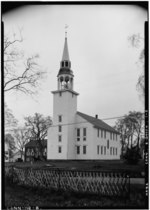Brooklyn Green Historic District
Brooklyn, ConnecticutFederal architecture in ConnecticutHistoric American Buildings Survey in ConnecticutHistoric districts in Windham County, ConnecticutHistoric districts on the National Register of Historic Places in Connecticut ... and 4 more
NRHP infobox with nocatNational Register of Historic Places in Windham County, ConnecticutNew England town greensUse mdy dates from August 2023

Brooklyn Green Historic District is a historic district on Route 169, Route 205, U.S. Route 6, Wolf Den, Brown, Prince Hill, and Hyde Roads in the town of Brooklyn, Connecticut. The district is notable for its Greek Revival, Colonial, and Federal architecture. It was added to the National Register of Historic Places in 1982.
Excerpt from the Wikipedia article Brooklyn Green Historic District (License: CC BY-SA 3.0, Authors, Images).Brooklyn Green Historic District
Providence Road,
Geographical coordinates (GPS) Address Nearby Places Show on map
Geographical coordinates (GPS)
| Latitude | Longitude |
|---|---|
| N 41.788333333333 ° | E -71.949166666667 ° |
Address
Providence Road 10
06234
Connecticut, United States
Open on Google Maps










